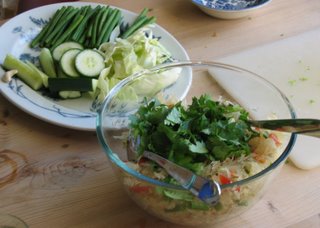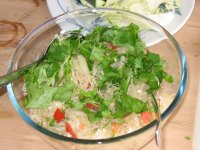Cookalicious gets organised
View the new, organised cookalicious.
I hope you find it easier to find the recipes you want.
 Panaeng Moo
Panaeng MooServes 4
I must admit to being a bit of a cheater on this one...I have a great recipe for Panaeng curry paste, but I've got into the habit of buying it from the Thai or Chinese supermarket as, unlike some bought pastes, this one has a really authentic flavour...its Mae Ploy Brand, the variety they call "Panang Curry Paste" has a blue strip at the top of the label. They do a whole selection of curry pastes, but the Panaeng is exceptionally good.

Keep your tub of Panaeng paste in the fridge, it will last for ages.
2 tins coconut milk - separated into a saucepan of the thin milk, retaining the thick milk (creamy, solid) for later
1 tin cold water (measure with the empty coconut milk tin)
3 tablespoons groundnut or similar oil
2 tablespoons Panaeng curry paste
2 tablespoons fish sauce
5 kaffir lime leaves - torn into pieces, discarding the stem
2 tablespoons palm sugar (or brown sugar)
2 big red chillies (optional)
Sweet basil leaves
Juice of 1 lime
Method:

 Asian Supermarket Staples
Asian Supermarket Staples Cooking Thai Rice:
Cooking Thai Rice: A thin, brown, salty liquid used instead of salt, similarly to soy sauce in Thai recipes. Darker sauces are higher in quality and have a strong fishy taste rather than being just salty.
A thin, brown, salty liquid used instead of salt, similarly to soy sauce in Thai recipes. Darker sauces are higher in quality and have a strong fishy taste rather than being just salty. Although fresh coconut is far superior, it is not something that is easy to get hold of here in the UK. If you fancy making it yourself I'll post a recipe for that in the future. For now, to get started, tins of coconut milk make an excellent substitute.
Although fresh coconut is far superior, it is not something that is easy to get hold of here in the UK. If you fancy making it yourself I'll post a recipe for that in the future. For now, to get started, tins of coconut milk make an excellent substitute. A strong smelling paste made from dried shrimps (so I'm told!), dark in colour and is used sparingly in soups, pastes and dips. These pots of paste last well in the fridge or larder. Anchovy paste can be used as a substitute, or anchovies and water blended is another option. Shrimp paste adds an intense fishy and salty flavour to dishes.
A strong smelling paste made from dried shrimps (so I'm told!), dark in colour and is used sparingly in soups, pastes and dips. These pots of paste last well in the fridge or larder. Anchovy paste can be used as a substitute, or anchovies and water blended is another option. Shrimp paste adds an intense fishy and salty flavour to dishes.
 Another few notes on Thai Ingredients
Another few notes on Thai Ingredients

 Ingredients for Pomelo Salad
Ingredients for Pomelo Salad
 On the table (from top-left): Pomelo, lime juice, limes, tomatoes, fish sauce.
On the table (from top-left): Pomelo, lime juice, limes, tomatoes, fish sauce.
 Spicy Pomelo Salad
Spicy Pomelo Salad

 2. Now peel away the rest of the tough pith around the pomelo segments and shred them roughly into smaller segments, as shown below.
2. Now peel away the rest of the tough pith around the pomelo segments and shred them roughly into smaller segments, as shown below.




 Thai Chicken in the Oven
Thai Chicken in the Oven Here's what it looks like after marinating, just seal up the foil and its ready to cook.
Here's what it looks like after marinating, just seal up the foil and its ready to cook. What's your Mince?
What's your Mince? Spicy Sweet & Sour Vegetables
Spicy Sweet & Sour Vegetables Another few notes on Thai Ingredients
Another few notes on Thai Ingredients



 Khaaw Neow
Khaaw Neow Laab
Laab 
 Chocolate Crispy Cakes
Chocolate Crispy Cakes Description of Ingredients and Substitution Ideas
Description of Ingredients and Substitution Ideas Ginger can be used as a substitute – but it has a much sharper flavour
Ginger can be used as a substitute – but it has a much sharper flavour
 Any type of chilli can be used as a substitute.
Any type of chilli can be used as a substitute. You can substitute any green bean (i.e. fine beans or dwarf beans) although remember that you'll need to buy about 3 times more!
You can substitute any green bean (i.e. fine beans or dwarf beans) although remember that you'll need to buy about 3 times more! There is no real substitute for Kaffir Lime Leaves, but if you're stuck you could try adding some lime zest instead.
There is no real substitute for Kaffir Lime Leaves, but if you're stuck you could try adding some lime zest instead. There is no real substitute for Kaffir Lime Zest, but if you're stuck you could use some normal lime zest and kaffir lime leaves instead.
There is no real substitute for Kaffir Lime Zest, but if you're stuck you could use some normal lime zest and kaffir lime leaves instead. Some supermarkets sell frozen Thai basil which is a good substitute.
Some supermarkets sell frozen Thai basil which is a good substitute.